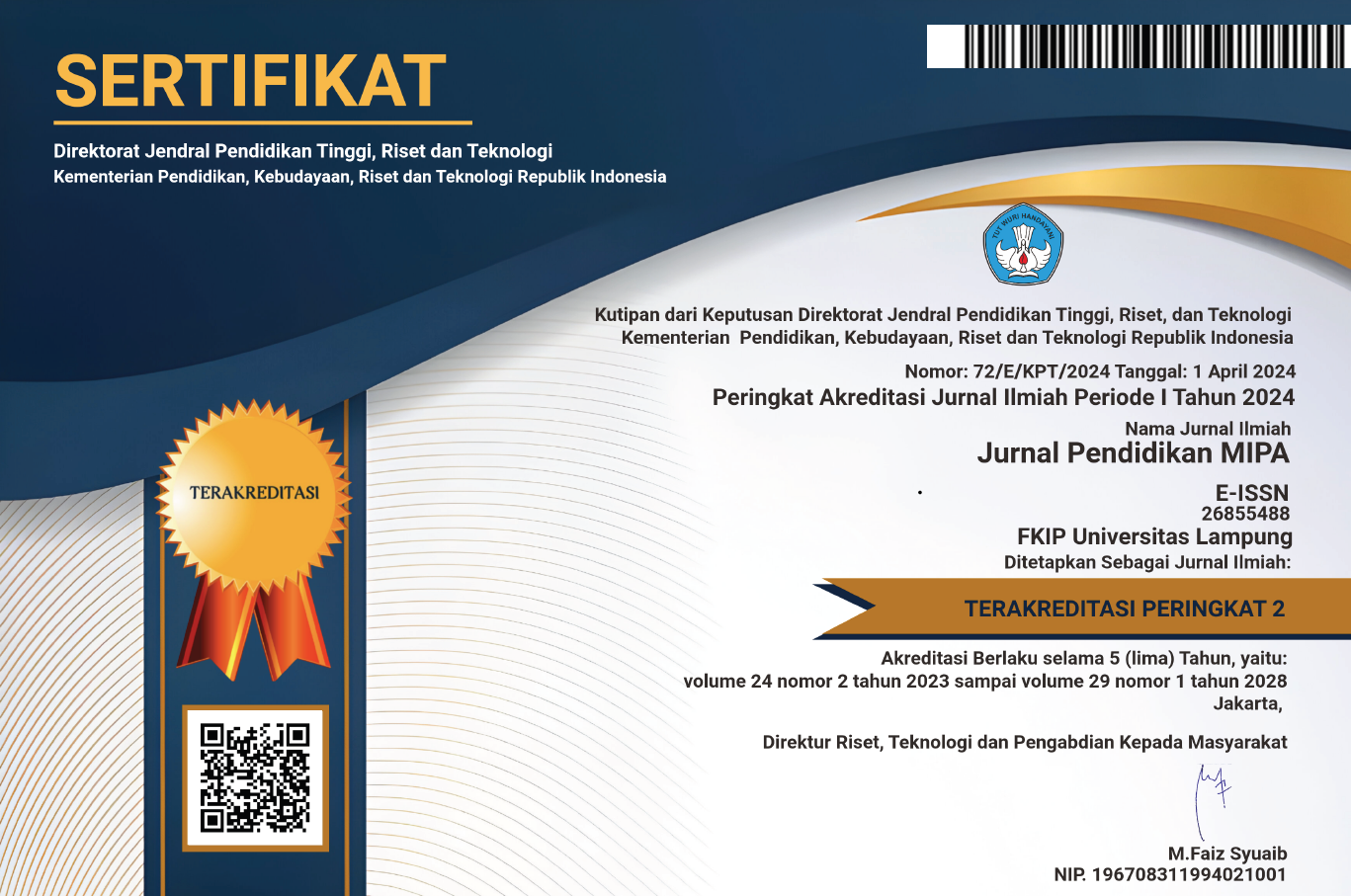Development of Arduino-Based Rotating Wheel as a Physics Learning Media of Circular Motion
 Country:
Country:
(1) Universitas Negeri Surabaya, Indonesia
(2) Universitas Negeri Surabaya, Indonesia
(3) Universitas Negeri Surabaya, Indonesia
(4) Universitas Negeri Surabaya, Indonesia
Learning media was used to explain the theory and minimize misconceptions. 50% of physics teachers in East Java have difficulty creating learning media of circular motion. Therefore, researchers created an innovation learning media and analyze the perception of physics teachers to Arduino-based "Rotating Wheel" learning media (ABRW). This research used R&D design with a 4-D model. The subjects were 24 physics teachers throughout East Java and 35 students’s XII MA Jabal Noer, Sidoarjo. The instruments used the form of teacher and student response questionnaires and material expert validation sheets. The data analysis is the calculation of the average value of validation results. The result from the physics teacher's and student response more than 65.8% and 75% in very positive category and validation more than 85% with a very valid categori. Thus, it was concluded ABRW props are feasible to use as well as learning physics in a circular motion topic.
Keywords: arduino, circular motion topic, learning media.
Canlas, I. P. (2016). Alternative conceptions on circular motion. International Journal of Scientific & Technology Research. Retrieved from http://www.ijstr.org
Dasilva, B. E., Ardiyati, T. K., Suparno, Sukardiyono, Eveline, E., Utami, T., & Ferty, Z. N. (2019). Development of Android-based Interactive Physics Mobile Learning Media (IPMLM) with scaffolding learning approach to improve HOTS of high school students. Journal for the Education of Gifted Young Scientists, 7(3), 659–681.
Desy, & Desnita, R. (2015). Development of physics props for circular motion matter for high school. Retrieved from http://snf-unj.ac.id/kumpulan-prosiding/snf2015/
Eveline, E., Ardiyati, T. K., & Dasilva, B. E. (2019). Development of interactive physics mobile learning media for enhancing students’ HOTS in impulse and momentum with scaffolding learning approach.
Firmansyah, J., & Wulandari, D. S. (2016). Application of generative learning models to reduce misconceptions in circular motion materials. Serambi Akademica.
Herdayanti, A., Rahmatsyah, & Manurung, S. R. (2020). Development of aid tool using Arduino Uno sensor for dynamic fluid at senior high school. Journal of Physics: Conference Series, 1485(1). Institute of Physics Publishing.
Hidayat, F. S., & Handhika, J. (2018). Papers. In Seminar Nasional Quantum (Vol. 25). Retrieved from http://seminar.uad.ac.id/index.php/quantum
Indrasari, W., Budi, A. S., & Fadilla, D. P. (2021). Development of a set of props for collision based on Arduino Uno microcontroller. Journal of Physics: Conference Series, 1816(1). IOP Publishing Ltd.
Iswanto, B. H., Nurwanti, O., & Budi, E. (2021). Sound resonance practice device based on Arduino Uno to improve the science process skills of high school students. AIP Conference Proceedings, 2320. American Institute of Physics Inc.
Kotseva, I., Gaydarova, M., Angelov, K., & Hoxha, F. (2019). Physics experiments and demonstrations based on Arduino. AIP Conference Proceedings, 2075. American Institute of Physics Inc.
Organtini, G. (2018). Arduino as a tool for physics experiments. Journal of Physics: Conference Series, 1076(1). Institute of Physics Publishing.
Prabowo, F. L., & Sucahyo, I. (2018). Pengembangan media hukum Melde berbasis aplikasi Physics Toolbox Sensor Suite pada materi gelombang stasioner. Inovasi Pendidikan Fisika, 7(2).
Pratiwi, U., & Fatmaryanti, S. D. (2020). Development of physics teaching media using speed sensors as speed analysis in real-time based on Arduino to remind students’ problem-solving abilities. JIPF (Jurnal Ilmu Pendidikan Fisika), 5(3), 151.
Rahma, A. M., Taqwa, M. R. A., & Pramono, N. A. (2020). Development of physics learning media with POE model-based corrective feedback for senior high school. Jurnal Geliga Sains: Jurnal Pendidikan Fisika, 8(2), 86–96.
Richtberg, S., & Girwidz, R. (2019). Learning physics with interactive videos: Possibilities, perception, and challenges. Journal of Physics: Conference Series, 1287(1). Institute of Physics Publishing.
Samudra, G. B., Suastra, W., & Suma, K. (2014). Problems faced by high school students in Singaraja City in studying physics. Jurnal Program Pascasarjana Universitas Pendidikan Ganesha Program Studi IPA, 4.
Sandjaja, D. P., Roza, L., Hidayat, M. N., Rosyid, F. A., & Makdiani, N. (2020). The development of viscosity practice tools based on information and communication technology using Arduino and Android on static fluid material for grade XI senior high school. Journal of Physics: Conference Series, 1491(1). Institute of Physics Publishing.
Sari, N., Sunarno, W., & Sarwanto, S. (2018). Analysis of student learning motivation in high school physics learning. Jurnal Pendidikan dan Kebudayaan, 3(1), 17.
Sari, U., & Kirindi, T. (2019). Using Arduino in physics teaching: Arduino-based physics experiment to study temperature dependence of electrical resistance. Journal of Computer and Education Research, 7(14), 698–710.
Tafonoa, T. (2018). The role of learning media in increasing students’ interest in learning. Journal of Educational Communication, 3(2).
Untara, K. A. A., Gustina, G., & Paramita, I. (2021). The development of oil-fueled gas steam stove as a learning media to enhance students’ curiosity. Jurnal Ilmiah Pendidikan Fisika, 5(1), 10.
Volfson, A., Eshach, H., & Ben-Abu, Y. (2020). Identifying physics misconceptions at the circus: The case of circular motion. Physical Review Physics Education Research, 16(1).
Wahyuni, N., Bhakti, Y. B., Mutakin, T. Z., Agustina, I., & Astuti, D. (2021). The development of four-tier diagnostic test instrument to identify the learners’ misconception on circular motions. IMPULSE: Journal of Research and Innovation in Physics Education, 1.
Widodo, S. A. (2018). Selection of learning media mathematics for junior school students. Turkish Online Journal of Educational Technology-TOJET, 17(1), 154–160.
Yolenta, D., Sutrisno, L., & Haratua. (2014). Deskripsi miskonsepsi siswa SMA Sekecamatan Kapuas tentang gerak melingkar beraturan menggunakan three-tier test. Jurnal Pendidikan dan Pembelajaran Khatulistiwa, 4(3).
Yusro, A. C., Pratama, H., Maduretno, T. W., & Hudha, M. N. (2019, June 7). Retraction: Analysis of the skills of physics teacher candidates in designing simple Arduino-based physics experiments. Journal of Physics: Conference Series, 1175. IOP Publishing Ltd.
Refbacks
- There are currently no refbacks.

This work is licensed under a Creative Commons Attribution-ShareAlike 4.0 International License.






